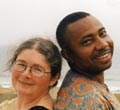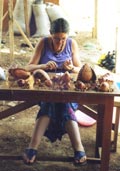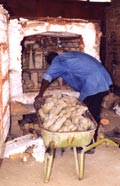
Francis &
I |

Assembling birds
|

Loading the kiln |
 |
Invitation card
to our exhibition |

Television
presenter |

Opening of
the exhibition |
| |
| Aba
House |
| |
| Francis'
Bronzes |
|
In France
I buy my clay neatly wrapped in plastic bags and ready to use.A
truck tips a pile of dried out clay, just as it came out of the
ground, by Francis' workshop gate. It needs to be washed to remove
the stones, bits of vegetation, and other debris, then dried to
a useable state. Then it has to be "wedged" - a process
to make it of uniform consistency. It is difficult to find large
plastic bags because there is no refuse collection system in Ghana,
and therefore no bin bags. Consequently they tend to only prepare
the clay that they wish to use immediately. The clay I was to
use had to be put in thin plastic bags of the type that they put
your shopping in. I had to be careful not to put holes in the
thin plastic as in the heat the clay dries out very quickly.
Ah yes - the
heat. I was working on the coast near Accra, the capital of Ghana,
which is almost on the Equator. It is not only hot, but for most
of the time very humid too. The only respite from this is when
the wind turns to the north and the dry Harmattan wind blows straight
down from the Sahara desert. It is then just as hot, but feels
much more pleasant as you are not constantly bathed in sweat.
However, it makes working in clay almost impossible. The dry wind
sucks the moisture out of the clay that you are using so fast
that it forms a crust that cracks constantly as you try to work
the clay. It also dried some of the pieces I'd already made far
too fast, and they cracked*. I protected some pieces with the
few available plastic sheets, and the small pieces dried fast
but survived the process, but there wasn't enough plastic for
everything. At the exhibition that Francis and I held I talked
to a potter from the north of Ghana, where it is very dry for
most of the time. The only way he can work when it is so dry is
to close all the doors and windows, put buckets of water on the
floor, and suspend sheets, that have their bottom end in the water,
from the ceiling,. This puts a bit of temporary humidity into
the air making work possible. He also uses a heavily grogged*
clay that resists fast drying.
The opening
of the exhibition came. and Francis and I made our speeches about
cultural cooperation for a better understanding of the world.
We were filmed and interviewed by the television company - to
be diffused on breakfast TV. But we're talking about the difficulties
of life in Ghana here. Francis had done his best to make everything
run smoothly, but not everyone cooperated. The printers had put
the wrong dates for the exhibition on the publicity and on the
banner outside the Alliance Française, where the exhibition
was held. The TV broadcast of the opening was screened the morning
I left Ghana - after the exhibition had closed. I was doing modelling
demonstrations at the exhibition some days, but my work mysteriously
broke in the night despite the security man...
All part of
the rich experience of how another culture operates!
It was all
fascinating, and despite being frustrating at times, it was overall
a wonderful experience. |
|





